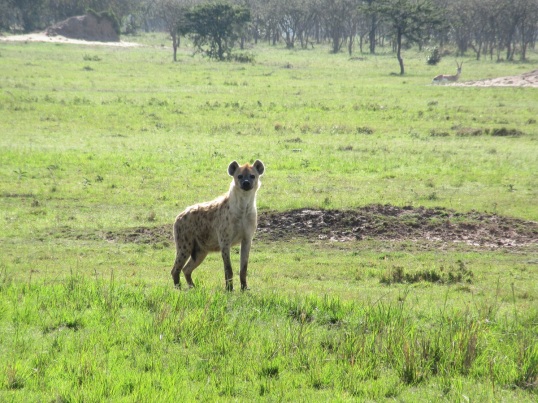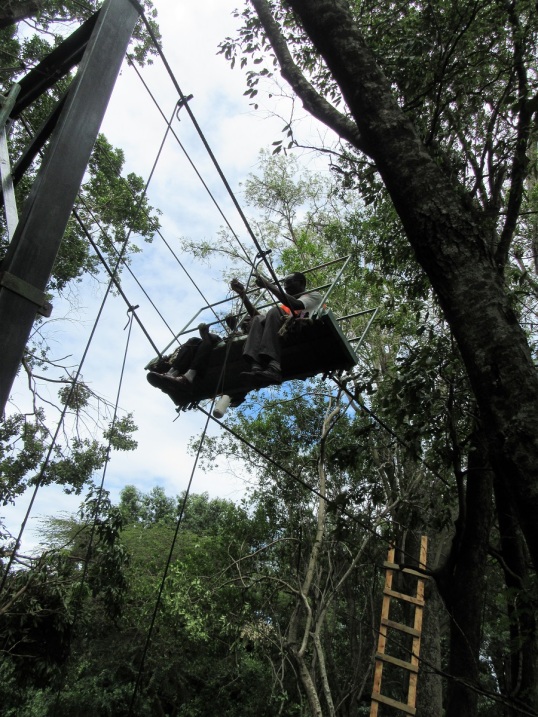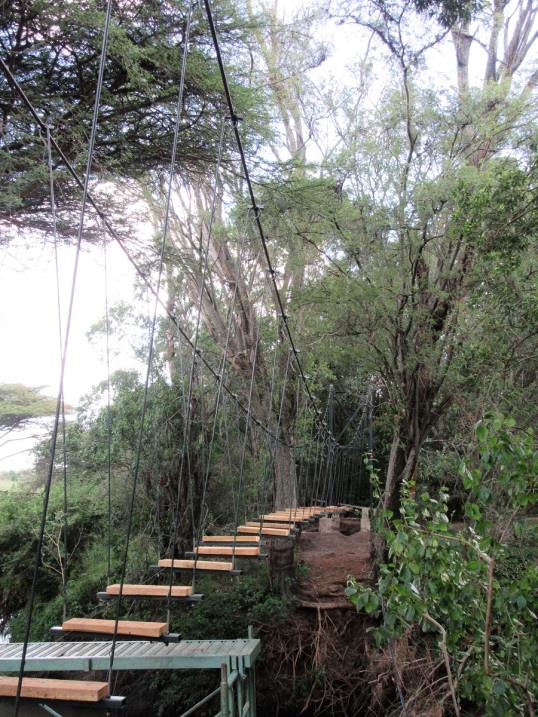Living and Breathing this Bridge
Today marks the beginning of week seven on the bridge site. Seven Sundays ago, Chris and I got into Harmon’s rugged red four wheel drive truck, left Nairobi and drove across Kenya, through the Maasai Mara, to this corner of the Olare Orok Conservancy at Mara Plains Camp. We jiggled over bumpy clay colored Kenyan roads weaving around seemingly bottomless potholes, through wet and slippery river crossings – slowly and with gritted teeth, Chris white-knuckling the steering wheel – avoiding unseen protruding rocks. We dodged dried up gulches formed by the hard, heavy, and fast rains that we would come to experience. We passed by Maasai men wrapped in red, herding their cows and goats or, on occasion, jumping (literally for joy, I’m told), the incredible African wildlife and under the Kenyan white swirling clouds and dramatic cerulean sky.


We made this journey on unmarked, unpaved, and uninhabitated conservancy “roads” using two navigation apps, a hand drawn map, and using such landmarks as: “sign posts”, and “the fallen tree” (we added our own such landmarks on subsequent trips into the bush town, Talek to buy supplies : the “bad river crossing” – turns out it was the correct river crossing, the “anthill”, the “small bent tree”, and the “carcass” – we learned our way without this one well before it disappeared). There have been many many trips across the conservancy; each time a unique and awe-inspiring experience – the windows down, no radio, no seat belts – just us and the enticing Kenyan countryside.




We have developed a routine, and are becoming….seasoned….a bit; we are understanding the rhythms of the camp – especially guest schedules which dictate what work we can accomplish (how noisy and messy can we be?), when the guys working on the bridge come and go, the daily temperature and weather (when it rains it becomes cold and soggy; otherwise, by our early afternoon rest, it is so hot that we are searching for the refreshing coolness between and underneath the pillows). We are even aware of the wildlife patterns we see daily and hear nightly. There are lions and hyenas calling, elephants foraging just outside the tent, wildebeest and zebras grazing on the horizon, and the nocturnal and elusive genet cat that has appeared on our deck several times.





So…..seven weeks ago, we arrived, met our new friends Ben and Holly (They are British/Kenyan late thirties camp managers who have many pre-Mara-Plains-Camp stories to tell about Iraq, Syria, South Sudan, Somalia and growing up in Kenya; they use words like “reckon” and “rubbish”).

After a tour of the camp, we started assessing the situation. The bridge spans 30 meters and is 600 mm wide; it was designed by a young American, son-of-African-missionaries Bobby Reese (we would come to call on Bobby for boots-on-the-ground-in Nairobi support, topping up our M-PESA account, bridge clarification and advice, along with some “engineering humor and banter”). Our work, here, has been to demolish the existing bridge (condemned due to damage caused by flash flooding and resulting river debris that tore the sagging Indiana Jones type bridge out of its usability), and then facilitate the build and assembly of the new Harmon Parker/Matthew Bowser/Bobby Reese/Chris Leibfried Tent 4 Bridge. The rest of the team are three skilled Bridging the Gap guys – Francis, Gordon, and Geoffrey – and 6 local workers – all hard working and agreeable guys (they all have taught me many Kiswahili words – numbers, animals, and bridge words like, well “daraja” or “bridge”; they laugh good-heartedly when I try to pronounce and use the words).

There is a sequence to building a bridge; Chris, as the site engineer, insists on precise and quality work (he is never far from his tape measure or Bobby’s bridge drawings). If you want to know about the sequence, I can even tell you; if you want minute details, that is a blog for Chris to write, or we can give you the Smugmug link containing 600+ photos I uploaded, documenting the process. First the layout of the bridge is set – this involves sighting heights, really long tape measures, and an ability to visualize something that is not yet there. After this, the guys dig holes – like it is their jobs. They hollow out four big-ass rectangular holes – two on each side of the river – for tower foundations and anchors. From here, we slowly assemble and erect the bridge “skeleton” – the towers, connect the two sides with the overhead cables and set the sag. Next two guys, in the “bitch box”, hang suspenders every meter. The suspenders connect the overhead cables and decking; they provide the surfaces for decking to be nailed onto lengthwise along the bridge. Eventually, everything is moored, we put a final coat of paint on, then add the remaining finishing touches. Ok, sorry you engineers, I left out LOTS of details…








The process involves the obvious: planning, measuring, digging, pouring, nailing, welding, screwing, hauling, drilling, sawing, painting and more. This is an oversimplification because there is much more happening. Mistakes are made and then corrected (no pictures here, please). Emails flow among Harmon, Matthew (the Canadian civil engineer soon to be coming on board BtGA – he also participates in the bridge banter!), Bobby, Chris and me; ideas and suggestions for alternative, and maybe better ways are discussed and sometimes changes are made. Once in awhile, a tool gets lost in the river below. Some mornings we break for chai and biscuits.Calculations are done on the palm of your hand. Often we must wait for guests who want to relax (aka guests who should be experiencing the bush from the land rover, not from under their covers!!) in order to progress through a loud process. Muddy feet are not uncommon. There is the possibility that someone develops a toothache and needs painkillers from the chemist in town. On a few occasions, math lessons emerge – triangles are drawn in the dirt along with an explanation of trig or principles of right angles – to an attentive and receptive audience of bridge workers.









Most of all what strikes me is the team work that is required for this project to be a success. This coordination comes from all angles, all levels. There is communication, discussion, hard work, mutual respect, and pride – this also comes from all angles.






We are almost finished. We have been living and breathing this bridge for seven weeks. I could philosophize about the metaphors involving a bridge, and I’ve thought of many. I’d rather share what an experienced friend of mine has said to me many times, “bridge building isn’t for sissies”. I know now that he speaks the truth.



xo.

Vertwillwritten!
No words, Just Wonderful!
Just ‘awesome’, that’s all…..
Amazing, the pictures are breathtaking, what an adventure!
What a phenomenal experience and production! Congratulations!
I love everything about this. You two are stars.